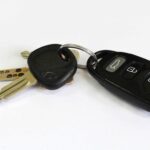Experiencing issues with your Nissan Altima key fob after a battery replacement can be frustrating. You might encounter an “Invalid Key ID” error, “No Key Detected” message, or find that the remote functions suddenly stop working. Fortunately, reprogramming your Nissan Altima key fob is often a straightforward process you can do yourself at home. This guide outlines common Nissan key fob problems and provides simple solutions to get your key fob working again.
Issue #1: “Invalid Key ID” or “No Key Detected” After Battery Change
This problem typically arises immediately after you replace the battery in your Nissan Altima key fob. While the key fob buttons for remote lock/unlock might still function, you’ll notice that the door request buttons no longer work, and the car displays an “Invalid Key ID” or “No Key Detected” message. You might also find that you need to physically press the start button with the key fob to start your vehicle.
Solution: Key Fob Reprogramming via Door Lock Procedure
This method involves using your physical key and the car’s door lock to reset the key fob recognition.
- Remove the Backup Key: Take out the mechanical backup key from your Nissan Altima key fob.
- Enter the Vehicle: Get inside your Nissan Altima, ensuring you leave the key fob inside the car.
- Cycle Ignition to “ON”: Press the start button twice without pressing the brake pedal. This will cycle the ignition to the “ON” position. Do not start the engine.
- Exit and Lock with Backup Key: Open the driver’s side door, take the backup door key with you, and exit the vehicle, leaving the key fob inside. Close the driver’s door.
- Lock and Unlock Manually: Insert the backup door key into the driver’s side door lock. Turn the key to the left to lock the door. You should hear the door locking mechanism engage. Then, turn the key to the right to unlock the door. Again, listen for the unlocking mechanism.
- Re-enter and Turn Off Ignition: Remove the backup door key and re-enter your Nissan Altima. Press the start button one more time (without pressing the brake) to turn the ignition to the “OFF” mode.
After completing these steps, the “Invalid key ID” or “No Key Detected” messages should disappear, and your key fob should function normally again.
Issue #2: Key Fob Buttons Not Working (Remote Lock, Trunk, Panic)
In this scenario, everything else with your Nissan Altima might work perfectly fine – starting the car, door request buttons – except for the remote functions on your key fob. The buttons for remote door lock, unlock, panic alarm, and remote trunk release (if equipped) become unresponsive.
Solution: ECU Reboot to Reprogram Key Fob Buttons
This issue often indicates that the key fob’s button functions need to be re-synchronized with the car’s computer (ECU). A simple ECU reboot while the key fob is inside the vehicle can usually resolve this.
- Locate the Car Battery: Open your Nissan Altima’s hood and locate the main car battery.
- Disconnect Battery: Using a wrench, disconnect the negative (black) terminal from the car battery.
- Wait and Reconnect: Wait for a minute or two. This allows the ECU to fully discharge and reset. Then, reconnect the negative battery terminal securely.
During this cold boot process, the ECU will recognize and reprogram the push-button functions of the key fob if it is inside the car. Keep your key fob inside the vehicle during this process.
Important Notes:
- Battery Type: The correct replacement battery for your Nissan Altima key fob is a CR2032. A CR2025 can be used temporarily, but it is slightly thinner and has a lower capacity, which may reduce its lifespan.
- Reprogramming Both Key Fobs: If you have two key fobs, you can attempt to reprogram both simultaneously by leaving both inside the car when performing either of the procedures described above. While not always necessary, it can be a time-saver if you are experiencing issues with multiple key fobs.
By following these troubleshooting steps, you can often resolve common Nissan Altima key fob issues after a battery replacement and avoid a trip to the dealership.
